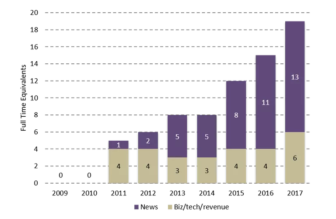
We lead a research project at the Shorenstein Center on Media, Politics and Public Policy at the Harvard Kennedy School called the Single Subject News Project, funded by the Knight Foundation. The project seeks to identify and share best practices on how single-subject newsrooms can engage, grow and monetize their online audiences. Our research falls at the heart of the Knight Commission’s mission, which is exploring ways to bolster trust in the media, including solvent and responsive news organizations.
The best practices for audience development and revenue which we are uncovering in our research on single-topic newsrooms are ripe for sharing with their local newsroom cousins. In this post, we are going to share some of the most important strategies we are discovering, which have practical application in local newsrooms. The first strategy is email newsletters and the second is search engine optimization (SEO).
But first, why should we expect that research on single-subject newsrooms should apply to local newsrooms? Local newsrooms and single-subject newsrooms share a number of characteristics. Both types of newsrooms tend to have small staffs, with a handful of reporters and editors who work long hours and wear multiple hats. Both types of newsrooms cater to a specific audience; either an audience with an interest in a particular topic (like criminal justice reform in America), or an audience in a specific geographic area. From a business model perspective, both types of newsrooms tend to be resource-constrained and in the midst of finding new and viable revenue streams to support their work. Finally, in the pursuit of new sources of revenue, both local and single-topic newsrooms are increasingly turning to reader revenue.
We are finding that email and SEO are critical to audience development and monetization in single-subject newsrooms. These are no doubt old-school web strategies. Yet in a digital news environment dominated by at-scale social platforms, and in the midst of an overwhelming amount of online content, we are finding that these two classics give newsrooms a degree of control and consistency in their publishing process which result in engaged audiences and high ROI.
Invest in Email Newsletters
Our research project was built on the hypothesis that email newsletters are one of the most powerful tools for audience building and audience revenue currently available to digital publishers. (To learn more about why we think the email newsletter deserves particular time and attention, check out the Shorenstein Center’s white paper on Using Data Science Tools for Email Audience Analysis. ) An effective email newsletter strategy relies on a clear editorial vision, a regular workflow and publishing schedule, a rigorous and ongoing set of email address acquisition strategies and paying attention to metrics that matter.
Craft an Editorial Strategy to Support Each of Your Newsletters
What we have learned from our cohort is that the newsletter should be the responsibility of at least one person on staff to write and produce weekly, and it should be written with a specific user persona from your readership in mind. Among our cohort, we’ve seen success among newsletters that include a portion with a personal voice and tone.
Be Systematic in Your Email Address Acquisition
A quality newsletter product is designed with a particular audience in mind, but how can newsrooms connect the right audience to the newsletter? We see email address acquisition as a vitally important, ongoing task that falls into two types: passive and active email acquisition.
- Passive email acquisition stems from how your website’s email sign-up boxes are designed and implemented. The homepage should have at least one prominent email sign-up box, preferably on the very top of the page in the form of a banner or pop-up. Stories, especially popular ones, should have an email box as well. Experiment with the placement, timing and design of your email boxes to see what works best for your site.
- Active email acquisition can take a few different forms: an email acquisition campaign where you work with a partner to co-host a webinar or event and share the email sign-up bounty, an advertisement on a platform, or a promotion of your email newsletter at an event. Try to understand which email campaigns yield the most engaged email newsletter users, either by manual analysis or by using our Python notebooks.
If you have an existing email address database and are looking to become more systematic in your email acquisition, we think there are a few questions worth asking: How did you acquire that group of users? Was it through a partner, a platform or your own site? Did you acquire them during a particular time of the year? What does that look back tell you that can inform your acquisition strategies going forward?
Pay Attention to the Email Newsletter Metrics That Matter
But producing a newsletter with a quality content strategy, a regular publishing schedule and a large audience is not enough. How can newsrooms tell if a newsletter is successful? What metrics should publishers and editors use to measure whether a newsletter audience is engaged and ready to be asked for support?
Besides creating excellent newsletter content, we recommend paying attention to a few particular email newsletter tasks and metrics when analyzing and setting goals, such as:
The number and percentage of users on your email list who open 80 to 100 percent of the time. Particularly for smaller news sites focused on producing coverage around one topic or area, the highly engaged email newsletter readers are your prime targets for small dollar donations or membership appeals. Focus on growing this core group of engaged readers and get to know what they like about your publication and newsletter through surveys or phone interviews.
The number and percentage of users who have never opened your email newsletter (or who haven’t opened one in the last six or more months). If a user hasn’t opened your email in the last six months, or has never opened one of your emails, try to re-engage them. Send them a re-engagement series of emails reminding them that they are subscribed to your email newsletter and pointing them to a few interesting stories or previous email round-ups. If the user still doesn’t start to open after this friendly reminder, manually remove them from your email list. It’s also worth the time to dive-in and try to understand why certain groups of users fell inactive, and how you can reorient time and staff resources to acquiring groups of users that will stay engaged in the long-term.
Invest in Search Engine Optimization
In addition to prioritizing the email newsletter as a method to build and monetize an online audience, we recommend investing in digital publishing workflows which bring organic search traffic to your site. Because single-topic newsrooms cover the same types of issues over time, and because their staffs tend to be small, incorporating SEO processes into daily publishing workflows is critical to ensuring that topical stories find interested audiences.
Local newsrooms as well need to rank well for the same search keywords over time, like the names of public officials in a geographic area, or words that a user would search to learn more about a particular local interest topic. It takes consistent work over time to build authority around certain keywords and therefore generate more organic traffic to a site.
SEO touches almost every part of a newsroom, from the tech team, to editorial, to audience engagement, so it’s tricky to figure out who will be responsible for which piece. We recommend asking questions like, who on the staff will be responsible for tracking high-performing keyword opportunities and integrating those into story production? Who will ensure that headlines, URLs and first paragraphs of stories are SEO optimized before publishing? Who will watch out for incoming links to ensure partners are linking to your content in the best, SEO-optimized way? To start, we recommend investing in a tool, like Moz, in order to track keywords and better understand any site errors.
Keep an eye out for an upcoming Single Subject News Project blog post that will showcase a few case studies on local and single-subject newsroom SEO workflows.
Invest in Business-side Personnel
In order for either SEO or email newsletters to be successful in growing and monetizing audiences, the newsroom first needs to prioritize hiring and retaining staff positions in its business, tech and revenue teams.

Image from Tim Grigg’s case study of VT Digger
We cannot agree enough with this analysis that we published from Tim Grigg’s case study of VT Digger on the ratio of news staff to biz/tech/revenue staff needed in a newsroom. As Tim puts it, speaking to the VT Digger model, “early investment in business development is crucial to build and keep momentum around donations, sponsorships, partnerships, and to create diverse revenue sources…Organizations that commit to business roles early on rather than having journalists try to do everything can grow further and faster and have stronger journalism as well.” Those individuals are particularly needed in order to coordinate and execute on the email newsletter and SEO workflows.
The Bottom Line
With the dedicated staff time and resources, SEO and the email newsletter are two controllable, measurable avenues to build and engage a habitual readership for single subject and local newsrooms alike.
In the age of changing social platform algorithms, ephemeral partner organizations and competitions for user attention from all angles, creating processes at a newsroom to generate a loyal, engaged, and supportive audience is worth the investment.
For a more comprehensive look on how to launch a local, nonprofit news outlet, we recommend this recently published playbook by two recent graduates of the Harvard Kennedy School.
This post first appeared on Medium and is cross-posted here with permission.
 Elizabeth Hansen is Research Fellow for the Single Subject News Project at the Shorenstein Center on Media, Politics and Public Policy.
Elizabeth Hansen is Research Fellow for the Single Subject News Project at the Shorenstein Center on Media, Politics and Public Policy.
 Emily Roseman is Research Project Manager for the Single Subject News Project at the Shorenstein Center on Media, Politics and Public Policy.
Emily Roseman is Research Project Manager for the Single Subject News Project at the Shorenstein Center on Media, Politics and Public Policy.
